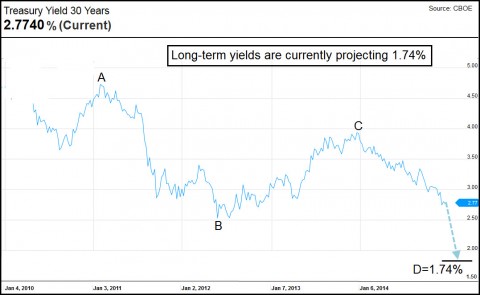Nothing in the technical picture has changed since we shouted “Buy T-Bonds!” from the rooftop in October. A commentary published at the time bore the headline Inflation, Deflation, and Our Very Confident Bet in T-Bonds. The bet has become even more enticing since then, mainly because even more investors have lined up on the wrong side of it. Wall Street, hedge funds, paper-shufflers, LBO artistes, TV pundits and economists all seem convinced the Fed will raise rates in 2015. The Wall Street Journal added to the drumbeat with an article asserting that it’s not a matter of whether the Fed will raise rates, but when. Oddly, the only mainstream pundit on our side of the argument is Paul Krugman, an economist with whom we’ve never agreed about anything before. He thinks tightening would be ill-advised because the U.S. economy is not nearly as strong as the spinmeisters would have us believe. That would be putting it mildly.

If the monetary hawks are right, we should be shorting Treasury paper up the wazoo rather than loading up on it, since bond prices move inversely to yields. We’ll take the odds. If ever there were a time to bet against the herd, this is it. It’s not a case of the smart money being dead wrong; it’s that the smart money is going to get crushed when it panics to unwind their epic mistake. Since every borrowed dollar is essentially a short position against the dollar, a day of reckoning logically awaits in the form of a dollar short-squeeze. Realize that all who have borrowed dollars, included mortgage debtors, are implicitly hoping they will be able to repay their loans in dollars cheapened by inflation. Deflation produces the opposite result, and merely because that result would wreck the global financial system is no reason to assume that The Powers That Be will be able to prevent it. When they ultimately fail, as seems inevitable, the dollar will strengthen precipitously. This will send long-term Treasurys into a bullish spasm that will make the October 15 spike – triggered by what Max Keiser wryly characterized as Japan’s QE9 — look like a PTA bake sale.
Buy T-Bonds, Gold and Short ‘Junk’
For now, investors would do well to shun stocks and stick with long-term bonds, hedging them with physical gold. Short junk paper while you’re at it, since the bullish herd has egregiously mispriced it as well. If barely restrained deflationary forces continue to weigh on bullion, as they have for more than three years, T-bond prices will benefit as interest rates fall. The leverage can be enormous for investors who position themselves far out on the yield curve (i.e., 20 to 40 years), since even a small downward shift in long-term rates can produce an instant and dramatic rise in long-term bond prices. We’d noted here six months ago that gains approaching 40% were possible if long-term rates tested their 2012 lows within twelve months. Investors who plunged into long-term bonds last January could be halfway there by now, with portfolio gains exceeding 20%. The chart above suggests not only that the plunge in yields has farther to go, but that rates are going to fall beneath 2012’s lows. Specifically, we’re predicting that yields on the 30-Year Bond are on their way down to 1.74%. This looks like a great bet to us – the moreso because nearly all investors are on the wrong side of it, braced for a promised Fed tightening that will never occur.
